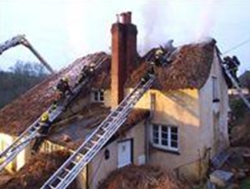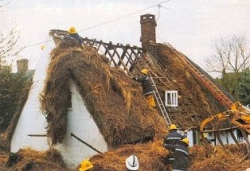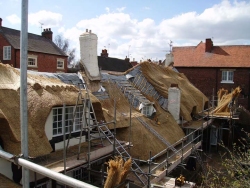Every year, between 70 and 100 thatched properties will suffer from a serious fire.
Since 2010 to the end of 2013 there was an average of 90 recorded fires per year in thatched properties. Conservative estimates of the cost of a thatch fire range between £150,000 - £300,000.
It is estimated that approximately 90% of thatch fires are chimney related and most are often associated with the installation of modern multi-fuel appliances (i.e. wood burning stoves). The potential for a fire is entirely dependent on understanding and managing the risks during the design and installation process, and subsequent usage patterns of these efficient appliances. Unfortunately, once started, thatch fires are almost impossible to control, therefore prevention is the most essential element that thatch owners should consider. If only detection is relied upon, it is almost impossible to save the thatch and, more importantly, the property itself.
With the recent introduction and trend for fitting multi-fuel appliances coupled with unsuitable chimney linings and less than ideal usage patterns, has directly contributed to the number of thatch fires in recent years.
In 1993 the National Society of Master Thatchers (NSMT) began a programme of research into factors affecting the longevity of thatch and it rapidly became apparent that one of the major factors was fire. When considering that about 45% of all thatched properties are listed, any fire or loss of a thatched property is especially distressing for the owner. This also represents an irretrievable loss of historical heritage.
In efforts to reduce the risk of fire, the NSMT examined the principle theories and realities of thatch ignition and 3 questions were raised;
- i) How easy is it to ignite the weathering surface of a thatched roof?
- ii) At what temperature does thatch ignite?
- iii) What size spark and type of spark would be necessary to ignite and sustain spread of fire on thatch?
Since most Thatch fires occur in autumn and winter, when thatched roofs are often wet or moist, this would make them harder to ignite externally.
With the assistance of several fire services, the NSMT were able to inspect thatched properties where fire shad been discovered. There findings where that an open fire proved to be at the lowest risk level than those with a multi-fuel appliance which proved to be the greatest risk. To understand this, the NSMT commissioned even more extensive research into this phenomenon and it was found that as thatch is such an efficient insulator and the high temperature flue gases, often in excess of 300°C, from enclosed appliances, is enough to start the charring process of the thatch material at the chimney to thatch interface.

 Thatch fires take hold quickly.
Thatch fires take hold quickly.
 After a fire the whole roof has to be striped.
After a fire the whole roof has to be striped.
 The cost of a rethatch is high.
The cost of a rethatch is high.